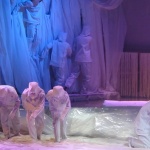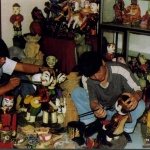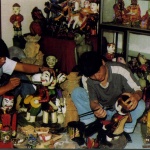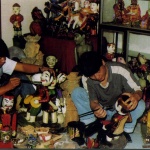Artist Vuong Duy Bien
For the first time (March 1984), Vietnamese water puppetry troupe arrived in Paris, Lyon, Marseille… (France) and several Italian cities were warmly welcomed by the public. It can be said that there has not been any foreign art troupe when performed in Paris made all newspapers (including right-wing newspapers) praised, although restrained.
From surprise to admiration, European audience gave our art special sentiments. The “World” Newspaper with the big title “Do not miss it! Water puppetry is great” or “This is an opportunity to discover and admire all the wonders of a thousand-year-art… Traditional art? Folk art? That's for sure” (Catholic Evidence Newspaper - April 1984), or as Mr. Serip Kaznada, director of the World Cultural House: “Water puppetry enriches the cultural heritage of humanity, preventing the risk of being pushed into the “hidden”, “forgotten”… state (March 1984). Recently, Vietnamese water puppetry is also welcomed in many cities in Japan and Australia, France, Germany, United Kingdom, Switzerland, etc.
Everywhere, our water puppetry is always a kind of favorite art. Why does it have that power? Why can it conquer Western Europe which has a long-standing culture? In order to find the answer, we return to the source for analysis and evaluation from a historical point of view.
Sung Thien Dien Linh stone inscription in Long Doi Pagoda (Ha Nam Ninh) records that “Puppetry was the circus show for Kings of Ly Dynasty in the Kings’ longevity wishing ceremonies” (XII century) có thể đã có. Thus, our puppetry has a long history of about 1000 years.
Vietnam country, Vietnam countryside is rich in fertile farmland, abundant bamboo and numerous of ponds, rivers, canals, etc. The life of farmers always associated with the buffalo herding, duck grazing, rice pounding, rice grinding, and “husband ploughs, wife transplants, buffalo rakes”, etc. The water puppetry was born in these scenes and separate emotions. The life on the river has defined the unique form of this art – water puppetry and water puppetry shaping.
That art exists parallel with the development of ancient sculpture, evident from the early period of consolidation of flourishing feudalism – Ly– Tran Dynasty buddhist sculpture to Le Dynasty royal sculpture and village communal house wooden sculpture at the end of Le Dynasty (XVI, XVII, XVIII centuries, especially in the XVII century when the village communal house wooden sculpture was standing firmly).
The audience comes to the water puppet show firstly to see the beauty, the appearance of the puppets. What is this animal? Who is this character? Good or evil? ... And since then, these characters have made the audience see the activity of a lively miniature society… Shaping art is considered as one of the most important characteristics in this art. It not only helps the audience recognize the face, shape of characters (life history) or animals (dragon, unicorn, turtle, phoenix) but also leads the audience to understand the meaning and content of a repertoire played by “puppets”.
Water puppetry shaping art depicts the royal traditional sculpture and the folk sculpture. These two elements cover all the ancient performances that we have known so far. There are two main types:
- The first type: Affected by folk sculpture (often depicted as life characters such as fish trapping, man fishing, fishing boat couple, rice grinder, rice pounder, etc.)
- The second type: Affected by royal sculpture (often depicted as national heroes such as Le Loi, Hai Ba Trung, Tran Nguyen Han, etc. and animals such as dragon, phoenix, crane, unicorn, etc.)
Although there are many types, there is almost a general concept of shaping: clear personality, playfulness, water-friendly (from size, color, weight to internal machinery)
You can see in each type a few main works to evaluate carefully. In the royal sculpture, the “Four spirit animals” (dragon, unicorn, turtle, phoenix) and the “Eight Immortals” is the most typical. Here, we see the face and spirit as when entering the temples, pagodas, communal houses, etc. The color of the traditional lacquer as well as the look and the way of finicky contour can describe the details of the eyes, nose, feathers, tail (such as dragon, phoenix, etc.) and folds of clothing, dress (of the immortals).
Contours in this type are usually smooth and elaborate sometimes meticulous. The dragon heads, unicorn heads, costumes of immortals are clearly decorated, even in the color of illumination. The strength is honored, as under the puppet is surface water. It makes the luster of the traditional lacquer more splendid. The patterns that we have encountered such as But Thap Pagoda, Tay Phuong Pagoda, Temple of Literature, etc. are fully inserted and “puppetized” to match the puppets and performance (performance of the puppets) without losing its traditional beauty. The talent of artisan is to express worship motif of temples, pagodas into “performance” for the audience and the audience also accept.
For example, in Le Loi yacht show, if the pagodas worshiping Le Loi in a respectful manner, conversely, in puppet shows, the audience was happy to see Le Loi was a small wooden statue can move, sit on a dragon boat, drew the sword out of its scabbard and lobbed it towards the golden turtle (The legend of Hoan Kiem Lake). Apparently, Le Loi was a king, who opened a dynasty, but under the eyes of puppet shaped art, King Le Loi is very close to common people, another aspect of honoring the national hero and cherishing the historical tradition.
In summary, the type takes on royal sculpture is one of the strongest segment of the puppetry. Not only strong in the performance, the important also is the impression of attractive decoration and shape.
The folk sculpture occupies a lot of typical shows of agricultural activities and wet rice civilized life such as: fishing boats, fish trapping, buffalo fighting, duck grazing, frog catching, ploughing, transplanting, etc. Unlike the above type, here, the audience is enjoying the creative style of fresh and conventional shaping. If in the above type, the rich imagination of art reached the top, then in this type, the “do what you see” viewpoint let the audience see the freshness and naivete. Puppets are eliminated many unnecessary things and kept what it needs to express.
For example, in the “Fishing boat couple” show, the couple with big bodies showing almost from the belly upward, so the upper part is much bigger than the lower part on the small boat… Or the “Fish trapping” show, two people who trap the fishes are small but fishes are very big (!)Thus, in the first show, the couple is main characters, and in the second show, fishes are main characters. Here, artisans will make the main character bigger for the audience to easily recognize.
The measure that not depending on reality makes the puppets more lively. The usage is daring and unstructured. Make art like playing, playing like real.
Romantic and daring look was clearly shown in “The old couple duck grazing”, the old man was wearing a loincloth, the old woman was a wearing a skirt and a women bib … while showing her long breasts … In fact, they was not so big? But in the “puppetry” the artisans exaggerated than in real life (meaning made the bib of the old woman smaller) to make the audience laugh –the laugh is very witty, funny but not vulgar.
In this type, the audience will encounter scenes of living, working and production of the farmers with muddy hands but is poeticized.
In the “Buffalo fighting”, “Agricultural activities”, etc. shows, the buffalo was stylized very close to the buffalo in the folk paintings which we often see today. They are simple contoured seemingly these animals are as rustic as humans (similar to the fish, duck, fox, etc.)
In general, the puppets’ shaping styles are fully affected by traditional sculpture and evolving through each period of history. However, when creating the puppets, the artisans have been skillfully modified to create a rather special type for the purpose of use for performance. Therefore, in addition to the beauty of contour, color, etc., the puppets have also clearly depicted personalities. The main characters – evil and good are all clearly defined (Lieu Thang is in opposition to Le Loi, the enemy is in opposition to the insurrectionists). The character personality is a factor that is focused in shaping. The common characters such as the old man duck grazing, the man frog catching, the woman transplanting, the woman fish trapping, etc have different aspects to express their jobs.
In combination with the contour, color is also used to enhance the character personality. The color of the dragon, unicorn, crane must be different from buffalo, duck, fish. Skin, clothes, and hat of Le Loi must be different from Lieu Thang. Even when drawing a beard or an eye should pay attention… to let the audience immediately recognize good and evil, recognize who is the villain, who is the protagonist.
Paint material has contributed a lot to create the charm for puppets. Indeed, with the space surrounding, the color has shown the best with its shiny, smooth, shimmering and glamorous.
In addition, it is necessary to mention some religious or divine shows (priest praying, whispered praying, parasol opening, sacrifices, koi fish becoming dragon, etc.) have color and shaping style of Hang Ma toys. Using the unreal to express the real, but successful and making the audience agitated.
In the water puppetry, in addition to the puppet, we must consider an indispensable element, it is the surface water. Why did our forefathers create an art that needed water? Is it because of life attached to rivers, ponds and lakes all the year round? … Obviously, water is a very important factor, helps puppets become active, lively and soulful. The surface water helps to hide the performance instruments such as pole, stick and wire while controlling the movements of the puppets.
The facial shape and water with reflective nature and wetness can create the scene virtualization, it shimmer, soften, smooth and change the shapes, lines, colors of illumination. Water is the space of the puppets, the surface water is using as the foundation for the puppets. Therefore, whether the water is clear or muddy, the shakiness and wetness water is the best place for romantic puppets.
Obviously, water is an indispensable element in the water puppetry that makes the puppets more beautiful, lively and attractive … And the best puppet is when standing on the water. “Water and puppets combined together, they are a symbiosis that resonate together to create efficiency”.
In addition to the water element, other elements such as firecrackers, fireworks, drums, gongs, wooden tocsins, flags, pennons, parasols, etc also enhance the special atmosphere of this “unique” art.
Imagine that the puppets were presented in a museum or a traditional room, and those puppets are presented in a space with the resounding cheers, the sound of wooden tocsins, drums, firecrackers and the flags … And those puppets can move, laugh, say, cry, etc. We will see two different effects and two different information values. Water puppetry displaying in the museum cannot be as effective as performing on the water. Conversely, when they are in the water, the audience will understand them better when they are displayed in museum glass cabinets.
In summary, the space of the water puppetry includes the above factors, together with the beauty of nature such as bamboo, pond, grass, trees, flowers, blue sky, wind, etc. It is a very unique, poetic and lyrical space. Our puppets “fall” into there as falling into a “miniature society”… In that place, the real is like the unreal, the unreal is like the real. They are always intertwined.
Our forefathers have skillfully exploited the traditional sculptures (royal sculpture and folk sculpture) to put the beauty into the puppet shaped art to make it worthwhile, and it has crossed the national boundaries so far.
We believe that, with the initial success (old puppet show that performed in Western Europe since 1984), we can develop the water puppetry in a promising new step that puppets having necessary artistic values, to harmoniously combine the nation and the modern, the respect and preservation of traditional culture and the selective absorption of the contemporary beauty.



